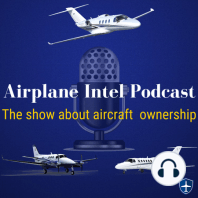54 min listen

Buying and Flying the Cessna Citation Mustang: A Very Capable Very Light Jet | Airplane Intel Podcast | Aviation Podcast
Buying and Flying the Cessna Citation Mustang: A Very Capable Very Light Jet | Airplane Intel Podcast | Aviation Podcast
ratings:
Length:
79 minutes
Released:
Nov 27, 2019
Format:
Podcast episode
Description
You’re lining up for takeoff on a cool, foggy morning. A recent frontal passage has left behind low ceilings, marginal visibility, and a thick cloud layer. If you were flying any other airplane, you probably would've canceled the flight. As an experienced pilot and airplane owner, you have confidence in yourself and your machine.Cleared for takeoff, you release the brakes and apply full power. The engines spool up quickly and evenly, pushing you ever-so-slightly into the seat. The throttles go all the way to the firewall without a second thought; no need to worry about over speeding or over-temping the engines thanks to the FADEC’s takeoff detent which automatically controls and monitors the engine’s output. With takeoff power set, acceleration is quite brisk. In just a few seconds, and only 3,000 feet of runway behind you, you reach rotation speed of 90 knots. Positive rate, gear up. At 400 feet, you bring the flaps up and bring the throttles into the climb power detent.In the blink of an eye, you’re in the clouds. It’s a fairly benign experience though thanks to the Mustang’s G1000 panel and GFC700 autopilot. Climbing out at 190 knots, you see climb rates close to 3,000 feet per minute. You could get even more with a slightly slower airspeed. In a matter of minutes, you’re through the thick cloud layer leaving you with blue skies and sunshine ahead. After a brief level off, you make it to your cruise altitude of FL350 in just 17 minutes. You could go higher, up to FL410, but today, the winds are more favorable at this altitude.With George doing the flying, you’re left to managing the airplane’s systems, supervising the automation, and talking to ATC. Handoffs come quickly with a cruise speed of 340kts true; that’s Mach 0.63, a pretty reasonable speed for a jet of this size, especially when you consider you’re burning about 85 gallons per hour.A typical flight for this airplane is about 500-700 nautical miles. A 600-mile flight would take you just shy of two hours with plenty of reserves. Useful load on the aircraft is 3,100 pounds, leaving you a full-fuel payload of about 700 pounds. That’s good for three average-size adults and their luggage. As with many general aviation airplanes, there’s always a tradeoff between payload and fuel.The top of descent comes quickly, and before you know it, it’s time to come down. Descents are easily managed thanks for the VNAV feature in the G1000 which can be set up for any arrival. In addition, the Mustang’s speed brakes can be deployed anytime to assist the airplane in getting down faster. The gear can be extended at a whopping 250 knots. With ADS-B, the Mustang can fly virtually any instrument approach with ease, including ILS and LPV. Thanks to the 3-axis GFC700 autopilot, the airplane can fly the approach down to minimums with a Vref approach speed of 90 knots, which is perfect whether you’re on an instrument approach or in the pattern.Touchdown is smooth and the airplane stops quickly. While there aren’t thrust reversers on the Mustang, the FADED keeps the engine idle RPM quite low, aiding in deceleration. Not to mention the speed brakes and big rig-powered wheel brakes. Landing performance is a generous 2,390 feet.That was a fun demo flight, but it’s time to make a decision. By now you're an experienced pilot and airplane owner. You've flown a lot of airplanes, and after years of flying pistons and a handful of turboprops, you’re ready for the speed, capability, and safety you can only get from a jet. But which one? There’s no one-size-fits-all solution; every airplane does some things well, and other things not-so-well.The Citation Mustang is a twin-engine, single-pilot certified, entry-level light jet built by Cessna Aircraft Company between 2006 and 2017. A total of 479 aircraft were produced with hundreds sold to owner/pilots. The Mustang boasts comfort, capability, performance, and efficiency while being a suitable next step for high-performance piston and turboprop owners. Equ
Released:
Nov 27, 2019
Format:
Podcast episode
Titles in the series (96)
005 - Jets, Maintenance + More: 005 - JETS, Maintenance, Anti-Ice + More by Airplane Intel Podcast - Aviation Podcast